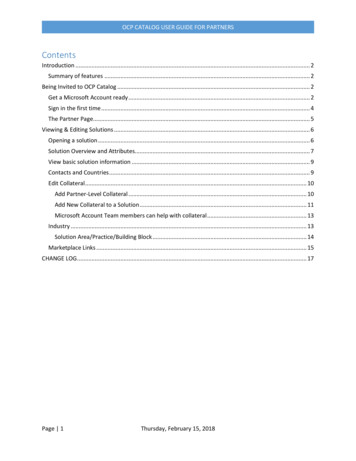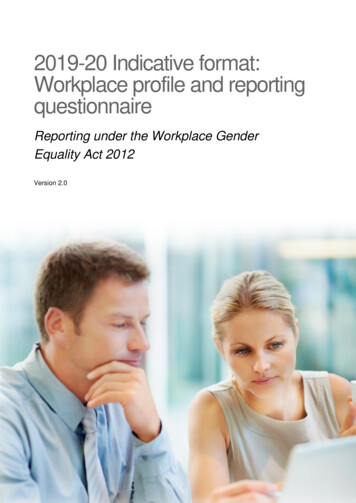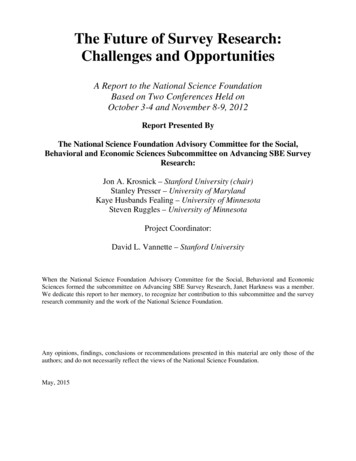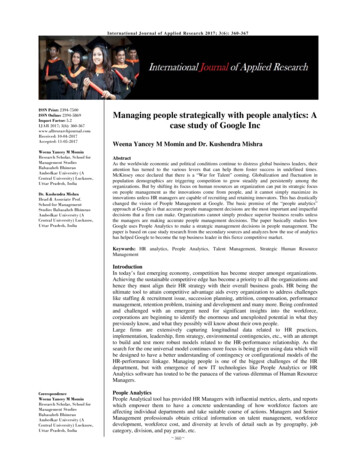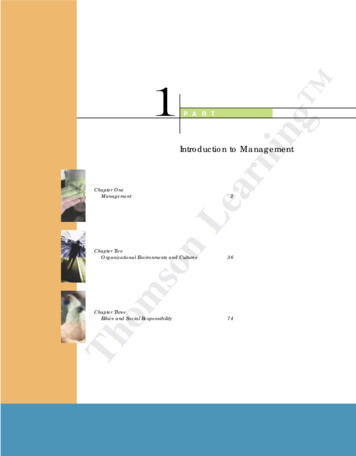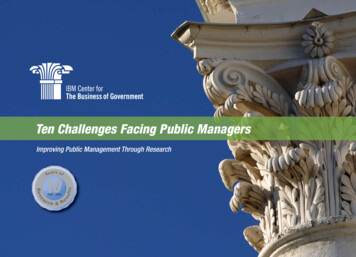
Transcription
Ten Challenges Facing Public ManagersImproving Public Management Through Research
Highlights of the IBM Center’s Past Ten YearsThe IBM Center for The Business of Government connects public management research with practice. Founded in 1998, the Center helpspublic sector executives improve the effectiveness of government through practical ideas and original thinking. The Center sponsorsindependent research by top minds in academe and the nonprofit sector.Research reports and books. Since its creation in 1998, the Center has awarded nearly 300 research stipends to leadingpublic management and business researchers in the academic and nonprofit communities, resulting in nearly 200 reports andbooks that focus on the major management issues facing government today.Radio show. The Center produces a weekly radio show, The Business of Government Hour, where we have interviewedover 300 government executives. The show is a conversation about management issues. Many public sector managershave shared how they are changing the way government does business through innovation and promising practices in theirorganizations. Podcasts and transcripts of these shows are posted on the Center’s website.Events. The Center hosts periodic seminars, symposiums, forums, and lectures on topics of relevance to public managers,featuring prominent leaders in the field. These events bring together those in government who are striving to bring innovationto the front lines. They provide an opportunity to hear, first-hand, from high-level government officials their points of view,challenges, and goals.
Magazine. Twice a year, the Center publishes The Business of Government magazine. The magazine features topical issuesfacing government managers, and also provides summaries of our reports, radio shows, and events.Website. We redesigned our website to make it easier to use and expanded its content to include more interactive features.New capabilities include a subject-based search, which compiles information from our reports, magazines, and radio shows;a key-word search; Really Simple Syndication (RSS) news feeds; Podcasting; downloadable two-page summaries to keepyou abreast of today’s topics; an email newsletter; and a more navigable homepage. Additionally, all our our publications andradio interviews are available for free. Our website is a popular destination with significantly more visitors every year. In 2007,the site saw hundreds of thousands of visitors. Visit the site at www.businessofgovernment.org.Media Citations. Our reports and our senior staff are regularly featured in publications read by government managers. In2007, we were cited more than 200 times in more than four dozen different publications and on the radio.
What’s AheadThe IBM Center has earned a reputation for a deep understanding of public management issues – rootedin both theory and practice – with a 10-year history of providing government leaders with instructive ideasthat inform their actions. We are a trusted source for practical ideas and original thinking from some ofthe best minds in academe and the nonprofit sector. We are seen as a respected and unbiased sourceof insights with a proven record for sponsoring salient research topics. In addition, we are looked to as asource for starting dialogues on a broad range of public management topics.Al MoralesFor the past ten years, the IBM Center for The Business of Government has studied the critical changesthat are underway at all levels of government in the United States and around the world. Along the way, theCenter has helped frame a number of significant management policy issues facing government.Jonathan BreulFor example, our case study on the Clinton Administration’s President’s Management Council contributedto its revival when President George W. Bush developed his management agenda. Our series of reports onthe use of partnerships and collaborative networks have helped policymakers and program managers learnto work across organizational boundaries in ways that achieve broader outcomes. Our reports on managingfor results, performance pay, and competitive sourcing have all contributed to a clearer understanding ofthe challenges, issues, and solutions government managers have encountered over the past decade. We
are now challenging agencies to develop new business models to exploit the advantages – and manage the risks – of new possibilitiessuch as web-based social media like blogging and the 3-dimensional Internet.However, the past is only the beginning. We remain committed to bringing independent thinking and practical insights to public sectormanagers. We need to constantly scan the horizons for the new challenges that will next face public managers. So while we celebrate ourpast decade, we look forward to the next. We have learned much during the Center’s first decade, and we plan to continue doing so inthe years ahead. Exciting change is happening throughout government, and we’ll continue to document and share that knowledge so youcan be inspired by, and learn from, the experience of others.The following pages are snapshots of what we see as ten “big challenges” in the decade ahead. We look forward to working with you tobring more solutions to government and to the public.
10 ChallengesFiscal SanityCrisis of CompetenceInformation OverloadGoverning Without BoundariesE-Government Is Only the BeginningGovernment by Contractors?Results Really Do Matter“Green” LeadershipSecurity and Privacy in a Flat WorldExpect Surprises
Fiscal SanityThe nation is at risk of drowning in debt – driven largely by federal commitments to support health care andretirement costs for baby boomers. What’s worse, rising health care costs are pushing state and local budgetsinto crisis as well. America’s current social insurance programs are both costly and antiquated. It is time to takea fresh look at reforming these programs to reflect current economic and budgetary considerations.The next president must devise a solution to these issues. All routes to salvation at the federal, state, and locallevels require reforming federal retirement and health care programs before they squeeze out other criticalnational priorities.Improving government’sability to manageeffectively will onlysucceed with long-termfiscal sanity.With creative and thoughtful solutions, and some tough choices from both the Executive and Legislative Branches,we can accomplish this goal. Focusing on fraud, waste, and abuse sounds tempting, but it won’t solve theproblem. Nor can we simply grow our way out of this problem. This will take discipline and leadership. Thesooner we get started, the better.2IBM Center for The Business of Government
Crisis of CompetenceMany fear a crisis of competence in the federal workforce. “Generation Y” has a strong service ethic, but notnecessarily in public service. Unlike Baby Boomers who may have spent their entire career in one job, the newgeneration doesn’t expect that to be the case. Key jobs in public service require substantial experience andtraining as the work of public servants has become more technical and service-oriented. For example, it takesfour years to be certified as an air traffic controller. In recent years, more controllers have retired than are beinghired and trained.Finally, with the experienced middle career ranks thinning out as Baby Boomers retire, the role of contractors hasincreased. Some fear an over-reliance on contractors for key public functions. However, the issue isn’t always“who does the work” but rather “do we have the right talent at the right time doing the right job with the right levelof accountability?”While there are legitimate issues around contracting out the public’s business, decisions must be made on thekind of work – and how much – should be delivered directly versus contracted out, or even delegated via grantsto states, localities and nonprofits. This will all hinge on the competence of the workforce needed to do the work.The majority of the babyboomer federal workforce isnearing retirement and theirchairs are at risk of being leftempty.3Ten Challenges Facing Public Managers
Information OverloadInformation overload is increasingly visible in daily life – cellphones, PDAs, email, and instant messages, forexample. This overload is also happening in government – hundreds of surveillance cameras in airports, a floodof weather and climate information, increasingly granular Census data, and real-time news events.The opportunities of “ondemand” information areoffset by the threat ofoverload that can lead tomissed information thatresults in bad decisions oreven disasters.The threats of information overload, and the possibility of missing important information needed to makeinformed decisions, has increased. However, breakthroughs in data capture, data standards, and data storagehave created opportunities for large-scale analysis. These new systems can extract the knowledge needed tocreate strategy-based solutions. They can also be used to create predictive forecasts and models that improvegovernmental responsiveness to future events – even non-routine events such as natural disasters, crime waves,or terror attacks. The challenge will be to develop government-wide, as well as mission-specific, information andanalytic functions.4IBM Center for The Business of Government
5Ten Challenges Facing Public Managers
Governing Without BoundariesGovernment is currently organized based on a presumption that the world is relatively stable and predictable,and that government’s work can be rooted in large-scale, repeatable routines. This hierarchical bureaucraticmodel was adopted in the mid-20th century from the corporate world. However, increasingly this does not reflecttoday’s realities. The corporate world has been struggling with how to best organize to deliver services that areincreasingly customized and unpredictable. This struggle is reflected in the public sector as well. The challengeon the frontlines of service delivery is to be able to combine knowledge and skills flexibly around changing tasks.Hierarchy and market-based mechanisms struggle with this.Government must transformitself to be less hierarchicaland more collaborative andtransparent.As a result, government is increasingly turning to non-hierarchical ways of doing business, often called“collaborative networks” and “boundary-less organizations.” However, these new models raise questions abouthow to govern effectively in a network-based environment. For example, how do you craft agendas and plans, setpriorities, and allocate resources across boundaries that are then accepted as legitimate, credible, and trusted byall those affected?6IBM Center for The Business of Government
E-Government Is Only the BeginningUsing information technology is no longer about doing the same things better. It is about recognizing thecommonality between agency programs, eliminating redundancy and embracing a customer-centric view.Technology makes it easier to move, manage and manipulate information anywhere on earth. It makes everythingmore visible. The technology part may be difficult, but the really hard part will be working across differentagencies to support the common customers of government.In this second wave of innovation, we will be challenged internally to work across agencies and we will bechallenged externally to redesign programs from the customer viewpoint. This is more of a cultural challengethan a technology challenge.Public managers will need to embrace the long hard slog to standardize and integrate their operations. Theywill need to reframe service delivery around the customer. They must do this in an environment where all theiractions are more visible and the nature of work and who does it is changing.Information technology ischanging our daily lives.Over the next decade, itwill change the role ofgovernment.7Ten Challenges Facing Public Managers
Government By Contractors?The federal government currently depends more on contractors than at any time in its history. This stems frompolitical limits on the number of government employees, a broken hiring process, and the need to ramp up quicklyto solve immediate problems. Highly experienced federal workers are leaving faster than new ones are coming onboard, while contracts are getting more complex. Those government employees who remain must contend witha toxic work environment, are under-resourced, under-supported, often under-trained, and blamed for any real orimagined program failure.For the past decade,government has increasinglycontracted out its operationswith little or no overallstrategy. It is time forrealignment.An effective government needs a strong cadre of contractors supporting a strong cadre of government workers,each in an appropriate role. Government must align its roles and capabilities so its programs are more effective.In doing this, it will save billions, and avoid the problems that come when it asks contractors to take on agovernmental role.The government needs to take a strategic look at contracting, decide how to manage it, the appropriate roles forall parties, and the right contracting methods. Most important, it needs to invest the necessary resources to makeworking for the government more attractive.8IBM Center for The Business of Government
Results Really Do MatterFocusing on accountable, results-oriented management can help government better position itself to meet thenew challenges and opportunities of this century. However, federal departments and agencies are confrontedwith long-standing and substantial challenges to becoming more results-oriented. Solving these problem areaswill require a performance-driven system that builds on crosscutting connections between agencies, levels ofgovernment, and the nonprofit and private sectors.To become high-performing organizations, federal departments and agencies must transform their cultures towork closely with other governments, nonprofits and the private sector – both domestically and internationally – toachieve results. Government needs to stick with practices that work and stop those that don’t. Part of this entailsa reassessment of federal missions and strategies, and the entire mix of policy tools available to address nationalobjectives. Because the public expects demonstrable results from the federal government, government leadersneed to increase strategic planning, address management challenges, use integrated approaches, and enhancetheir agencies’ results-orientation.Technology is shiftinggovernment’s focus fromagencies and programs toservices and results.A focus on results, not just of the organization, but of its contribution to national goals, is essential. In establishinga results-oriented culture that can reach its full potential, the organization and its leaders must carefully select thebest solution for the organization in terms of structure, systems, and processes.9Ten Challenges Facing Public Managers
“Green” LeadershipOver the past decade, global warming from the burning of fossil fuels has moved from a high probability to anear certainty. Everywhere on earth the environment faces unprecedented stress from economic growth andincreasing energy use. How we and the rest of the world address the environmental challenge will largelydetermine the quality of life for ourselves, our children, and generations to come.Society is pushing the limitsof what the environment cansupport. Government mustlead the way in responding toenvironmental challenges.Technology and markets will play a crucial role, but government actions will be just as critical. People haverepeatedly demonstrated innovative approaches around limits to growth if the incentives are right, but this isnot yet the case for energy and the environment. Markets on their own undervalue the environment and fail toencourage many energy conservation investments that are economically sound. Many environmental issues, likethose resulting from green house gases, require a global approach since little is accomplished if reductions in onecountry are cancelled out by increases in another country.Solving our environmental problems requires a blend of public policies and incentives that encourage technologyand management innovations across the globe.10IBM Center for The Business of Government
Security and Privacy in a Flat WorldSecurity and privacy issues need to be explicitly factored into any technology decision. The Internet, cheap datastorage, wireless capabilities and a host of other technologies have helped fuel a decade of economic growthand governmental innovation. Yet, these technologies potentially carry many risks. Since we depend on themmore, they matter more. Since they tend to be the same everywhere, vulnerability in one place tends to meanvulnerability in all places. Since they reach everybody, they require that we distinguish between who to let in andwho to keep out. Finally, they make it hard to forget. As we use the Internet or text on a phone, we leave behinddigital “crumbs” that others can followRisks need to be assessed and addressed. Policies need to be developed. In some cases, the most efficientsolution must yield to the more secure solution. For security, this is primarily a need to resource and plan forknown risks, and hedge against unknown risks.Privacy issues raise concerns about the role of government. As a society, we have the choice of allowingtechnology to help the government watch over us (with all its good and bad connotations) or using technology tohelp us watch the government.Technology interconnectsalmost everyone on earth.We need to capture theadvantages while managingthe risks.11Ten Challenges Facing Public Managers
12IBM Center for The Business of Government
Expect SurprisesGovernment proved no match for Hurricane Katrina. The country can’t afford any more fumbled responses tocatastrophic or non-routine management challenges, whether caused by natural or human means.In the coming years, public leaders can count on more than their share of catastrophic and non-routinemanagement challenges – for example another breakdown in the food safety system, a pandemic, a West Coastearthquake, or bio-terrorism in a major urban area. Responding to such challenges with traditional managementapproaches will only produce the same results seen in Hurricane Katrina.With the government facing an array of complex challenges and opportunities for improvement, a strategic,long-term view is critical. Government must carefully consider how best to design programs to manage effectivelyacross boundaries and meet the nation’s needs and priorities today and in the future. Policymakers will needforward-looking information to set the stage for early warnings about emerging threats and to make informedchoices about effective government responses.A government designed forefficient, routine operationsis increasingly expected todeal with unexpected, nonroutine events.13Ten Challenges Facing Public Managers
Looking to the Future at the IBM CenterWe have learned much during the Center’s first ten years, and we plan to continue doing so in the years ahead.Exciting change is happening throughout government, and we want to continue connecting research to practice.Improving government performance remains a complex and difficult assignment – both technically and politically.It is our aspiration to continue to serve as a trusted resource for government executives by providing them with practical insightand foresight on the transformation of government underway in the United States and around the globe.We are excited about the next ten years and continuing to develop and communicate new ideasfor improving the management and performance of government. It should keep us busy. Stay tuned!
For the past ten years, the IBM Center for The Business of Government has studied the critical changes that are underway at all levels of government in the United States and around the world. Along the way, the Center has helped frame a number o
